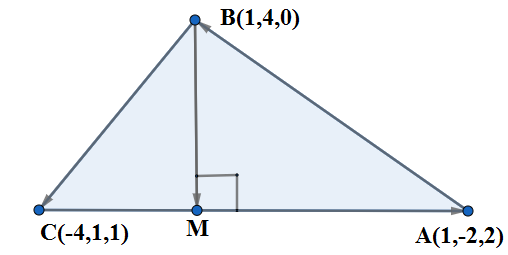Question
Question: The triangle ABC is defined by the vertices \(A\left( 1,-2,2 \right),B\left( 1,4,0 \right)\) and \(C...
The triangle ABC is defined by the vertices A(1,−2,2),B(1,4,0) and C(−4,1,1) If M be the foot of the altitude drawn from the vertex B to side AC, then BM= $$$$
A. \left( \dfrac{-20}{7},\dfrac{-30}{7},\dfrac{10}{7} \right)$$$$$
B.\left( -20,-30,10 \right)
C.$\left( 2,3,-1 \right)
D.(1,2,3)$$$$
Solution
We know that the ray from point P(x1,y1,z1) and Q(x2,y2,z2) can be represented as the vector PQ=(x2−x1)i^+(y2−y1)j^+(z2−z1)k^. We represent the sides as the vectorsAB,BC,CA. We find position vector point on the line as a+λd where a vector is the potion vector of vertex C and d=CA as the direction vector. We use the perpendicular condition of vectors BM and CA to find λ. $$$$
Complete step-by-step solution: ’

We are given the coordinate of the vertices A(1,−2,2),B(1,4,0) and C(−4,1,1). Let us represent the sides as vectors. We have;
